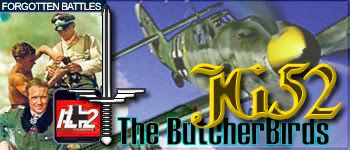
 |
|
|
|
#1
|
||||
|
||||
|
Hello everybody,
Here's a few questions for the experts at hand: I keep reading that all M-105 engines had ordinary carburettors and thus suffered from neg. G cutouts and that the VK-107 was the only operational Klimov engine with fuel injection. Same for the early M-82 engines (M-82A and M-82F found on the La-5 and La-5F). So, should all Yaks (excluding the Yak-3 VK107 and Yak-9U) and LaGGs as well as the La-5 & La-5F suffer from neg G cutouts as we see them on the early Spitfires now?
__________________
 The tiger has no smell and makes no noise but you know he is there There is something in the shadows - its the tiger waiting for you Last edited by JG52Karaya; 03-09-2011 at 08:38 AM. |
|
#2
|
|||
|
|||
|
If this should be true I would like TD to put this on the top of their to-do list.
Souldn't be to hard as they can draw heavily from the I-16 engine cut-out code and the new early Merlin code. Last edited by Zorin; 03-09-2011 at 12:47 AM. |
|
#3
|
|||
|
|||
|
Quote:
True for very early 1939/1940 aircraft such as the very first Yak 1's as these were equipped with the M-105P. From the M-105PA (1940/1941) onwards a new carburetor (without a float chamber) was used avoiding the negative G problem. |
|
#4
|
|||
|
|||
|
Another thing, the US radials. Why don't they suffer from the same cutout as the Gnome-Rhône engines? They use the same Stromberg carburetor so there should be no difference in fuel injection, right?
|
|
#5
|
|||
|
|||
|
Quote:
http://www.ww2aircraft.net/forum/eng...tem-14815.html |
|
#6
|
||||
|
||||
|
From looking at the thread it sounds like there were two types of Stromberg carbs, one with the pressure injection system that was used on most of the engines 1800 in^3 and up, and a float carb version that was used on most of the smaller engines. My guess is that the Gnome-Rhône engines used the float version, and the US versions used the pressure injection system.
As I understand in, the US Navy selected their fighters heavily for acrobatic performance*, so inverted flight was a high priority for them. Both the Spitfire and Merlin engine, on the other hand, evolved out of racing, where inverted flight wasn't a typical mode, so inverted flight systems could easily have been over looked. There is actually a lot of design work that goes into making a plane fully inverted capable, and not all of it is thing that you'd think of right off the bat. *This was the reason the Brewster Buffalo was initially chosen over the Wildcat, and why the Wildcat had the crazy riveted construction it did. Yes, the unloaded Buffalo, with its one piece wing was more acrobatic than the Wildcat. |
|
#7
|
|||
|
|||
|
Is it correct that all the I-16 engines cut out under negative g?
|
 |
|
|